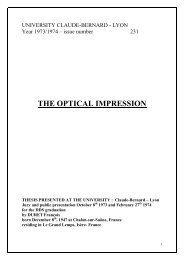english version(pg40to78) - Pr. François Duret
english version(pg40to78) - Pr. François Duret
english version(pg40to78) - Pr. François Duret
You also want an ePaper? Increase the reach of your titles
YUMPU automatically turns print PDFs into web optimized ePapers that Google loves.
F <strong>Duret</strong> and Coll. <strong>Pr</strong>incipes de fonctionnement et applications techniques de l’empreinte optique dans l’exercice de cabinet<br />
(traduction Anglaise)<br />
Page 76<br />
We are going to successively envisage the functioning of each part<br />
before approaching the applications and exploitation technical data<br />
linked to the use of the EO device.<br />
The wave projection system and dental shape capture<br />
REMINDERS AND PRINCIPLE’S HISTORY<br />
There are several modes of tri dimensional capture of an object (Fig.<br />
4).<br />
♦ The first is chemical natural 1 and corresponds to our capture<br />
with impression pastes. The data is transmitted in positive by a<br />
plaster model (for example) to a laboratory technician.<br />
♦ The second is mechanical electronical² as it uses complex<br />
surfaces micro probes. This method is being studied, without<br />
great success in our profession for the last 15 years in the USA.<br />
♦ The third capture mode is opto-electronic as it uses both<br />
ondulatory and photonic characteristics of the light and the<br />
electro-physical possibilities of matter. We won’t hesitate to say<br />
today that it is the only approach mode valid and promised to a<br />
great future in the dental surgery world. We use this approach<br />
for the last 12 years with extremely promising results.<br />
[Fig. 4: 3 modes of measuring an object]<br />
Les Cahiers de <strong>Pr</strong>othèse (50) pp 73 – 110, 1985



